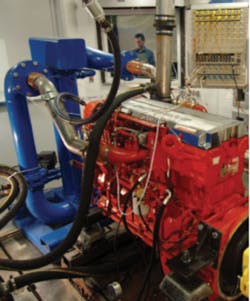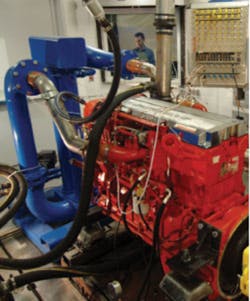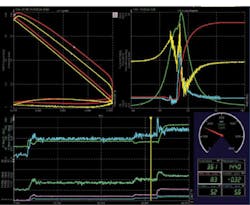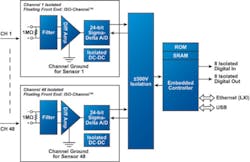Data acquisition (DAQ) systems are key to automotive tests ranging from engine development to interior buzz, squeak, and rattle noise abatement. Overall, tests split into those that are performed in a lab, typically on separate components or assemblies rather than the entire car, and others that require the test instrumentation to be mounted in the car and used while it is being driven.
Modern vehicles have sufficient electronics that many parameter values are readily available on internal buses. Rick Walter, general manager at HEM Data, commented, “DAWN™, our data acquisition with in-vehicle networks system, can be configured to record both automotive and heavy-duty in-vehicle data. The instrument is compatible with the CAN protocol as well as J1939, ISO15765, J1850, J1708/1587, ISO9141, and ISO14230. DAWN simultaneously acquires data from the in-vehicle network, GPS, and analog signals produced by sensors.”
IHR also makes a range of network testing and emulation equipment including the CANstick Basic, a CANbus communications logger; and the Emulin, a LINbus emulator. The Emulin instrument tests LINbus waveform boundaries and can provide a LINbus environment during development. IHR’s products are technically supported and sold in the United States by Saelig.
The basicCAR 3085 from GOEPEL electronic is a compact automotive network tester that measures CAN and LIN responses to stored test setups. According to Managing Director Manfred Schneider, “GOEPEL’s interface controllers generate all communications protocols on-board. Users only have to access and parameterize the protocols, which run in real time. Fault simulation is included along with stimulus-response functionality, automatic generation of check sums, and message counters.”
In addition to in-car and lab-based segmentation, the series of brochures that Dewetron has developed suggests test categorization by application: road load, ride and handling, combined active and passive safety (CAPS), combustion analysis, pass-by noise system, and tactical/land vehicle test. As you might expect, many of these test areas benefit from DAQ features that Dewetron highlights such as synchronized recording across several channels and signal types, isolated inputs and CAN BUS interfaces, and built-in battery operation.
Dealing with many types of signals creates two kinds of DAQ challenges: provision of the right sensor and the capability to handle the signal it produces. Dewetron’s Model Dewe-3143 ThinHAND-43 DAQ System has eight universal inputs that accept full-bridge or voltage signals. Excitation up to 10 V also is included, and both the inputs and excitation are isolated. A series of smart adapters converts these inputs to accept thermocouples, charge-type accelerometers and microphones, voltages up to 200 V, and RTDs.
Clearly, it is attractive to address as many applications as possible with basic DAQ hardware, altering only plug-in modules, software, and accessories as needed. This is the approach taken with Hi-Techniques’ Synergy DAQ System, a general-purpose instrument that can be configured to handle a wide range of test requirements.
One example relates to the recent trend to hybrid and all-electric vehicles that has resulted in much higher voltages than the usual 12 V or 30 V to 42 V found in a few new cars. The Hi-Techniques Model SY6216-4D-VI is a four-channel amplifier module that provides a 1,000-V input range with 1,000-V channel-to-ground isolation and 2,000-V channel-to-channel. The 500-V common-mode voltage and 16-b resolution mean that the amplifier can measure off-ground signals such as one element of a fuel cell or a multicell battery.
Geotest’s Mike Dewey, senior product marketing manager, commented, “We see the need to offer test components that are compatible with the high working voltages and currents found in hybrid propulsion systems while preserving a high dynamic range and resolution. This means [developing] switching systems that can withstand high stand-off voltages and digitizers with high dynamic range and at least 14-b resolution.”
Although many types of automotive tests are performed, a few have special requirements that set them apart. Engine testing is a major area for obvious reasons. Not only must an engine design provide power, economy, and low emissions, but it also has to achieve good durability and low manufacturing costs. Figure 1 shows a large engine being tested in one of Ricardo’s many test cells. The company, headquartered in the United Kingdom, specializes in engine design, analysis, and test.
Engine Testing
For a conventional internal-combustion engine, the area inside the pressure-volume (PV) curve indicates the amount of work output per cycle. This is the reason that PV analysis is so important. Of course, during a complete two-revolution cycle of a four-stroke engine, valves open and close, fuel is injected, and the ignition pulse is delivered. The timings of all these events relative to the crank angle (CA) determine how well the engine performs.
Larry Trammell, technical marketing manager at Microstar Laboratories, explained that the company’s DAQ equipment typically is used in applications requiring high measurement precision, large channel count, and active data preprocessing, “Perhaps our best success is in combustion testing for which you need to measure temperatures, pressures, and fuel flow at a set of known angles through a multistroke cycle. That’s one set of timing requirements dictated by device rotation speed.
“However,” he continued, “when you reach a measurement position, you must capture data for all cylinders and sensors very quickly, and that’s an additional, very different set of timing requirements. Measurements must not be vulnerable to noise from high-energy discharges, but [the system] cannot sacrifice accuracy or speed.”
Typically, a charge-mode piezoelectric pressure sensor with a matching amplifier is used to measure cylinder pressure. A rotary encoder may provide the sampling clock as well as indicate top-dead-center. The cylinder volume above the piston is calculated as a function of CA based on the engine dimensions and geometry.
Hi-Techniques’ Synergy DAQ system with REVelation II Combustion Analysis Software uses this test setup. Angular resolution as fine as 3,600 samples/revolution is supported up to 30,000 rpm. Real-time measurements include peak pressures, heat release, and mean effective pressures (MEP). It is desirable to directly sample parameters relative to CA to account for the differences in angular velocity that occur throughout a revolution, especially during acceleration. On the other hand, attaching a precision shaft encoder may not be practical outside of an engine test cell.
CA-based sampling is fundamental to order tracking. Typically, vibrations occur at multiples of the crankshaft rotation speed. These harmonics are called orders. When considered in the time domain, the spectra associated with these disturbances vary with engine speed; in the angular rotation domain, they do not. This means that a wide range of frequency-domain analysis tools can be used if engine data is presented relative to the CA.
Dewetron bases its combustion analysis application on the ORION DAQ card, which accepts a variety of bus, event, and analog signal types, sampling them with an internal or external clock. The combustion analysis brochure explains, “A standard combustion analyzer uses external clocking to get [an] angle-based view…. The disadvantage of such [a] setup is that the time information is missing…. Internal clocking with a fixed sampling rate avoids this problem. The Dewetron Combustion Analyzer uses resampling technology to record in [the] time domain and transfer all the CA-related values to [the] angle domain” (Figure 2).
Resampling to the angle domain presupposes knowledge of the instantaneous crank rotation speed, which must be recorded from a shaft encoder at the same time as the time-domain data and at a high enough sampling rate to accurately timestamp each encoder pulse. For some tests, sensing flywheel ring-gear teeth provides sufficiently fine angular information.
It is desirable to have many pulses per revolution because if only a few pulses are available, a resampling algorithm cannot accurately track fast acceleration. Having made the case for time-based data acquisition, Dewetron’s Combustion Analyzer also supports external clocking.
In fact, each method has its place. Time-domain sampling may be the best approach for slowly changing processes such as cold starting with lots of cranking over a matter of seconds. Because the engine might be turning at only one revolution per second, a 1-MHz sampling rate is equivalent to about 0.0003 degrees resolution or 300 times better than a 3,600-pulse encoder. You can see what’s happening microsecond by microsecond rather than just having a series of snapshots taken at 300-µs intervals.
Conversely, if you suspect there’s a crankshaft torsional vibration excited by rapidly accelerating from 11,000 to 12,000 rpm, you probably can’t afford to introduce even small timing artifacts through resampling. For this example, the precise angular sampling of the shaft encoder would be the better choice.
To put the sampling rate into perspective, 12,000 rpm is equivalent to 200 Hz, so even using a 3,600-pulse encoder results in a manageable 720-kHz sample rate, and the samples are angularly accurate. Nevertheless, sampling pulses derived from a shaft encoder only represent motion at one end of the crankshaft. This is a fundamental limitation for some kinds of engine research.
In addition to strictly internal or external sample timing, many types of rotational time bases have been produced—internal time bases used to directly sample engine parameters but synchronized by external angular inputs. Virtually all these attempts are inferior to the latest DSP-based digital resampling techniques. Some earlier methods held the sample rate constant between external updates, which eliminated the capability to smoothly track fast acceleration. Other attempts were based on PLL technology that introduced time delays equivalent to angular position errors, especially during rapid acceleration.
In any type of DAQ system, appropriate filtering must be provided to avoid aliasing. This requirement applies to both external angle-based sampling as well as fixed time-interval sampling. Because angle-based sampling implies a variable rate, this can be the more challenging acquisition mode.
Vehicle Dynamics
Braking performance, audible noise, tire temperature, electrical system voltage and current, and any number of force and acceleration signals often are measured while a car is being driven. Alternatively, some of the required data can be collected under simulated conditions provided by a dynamometer or a dynamic suspension test rig.
For lab testing, the shape, size, ruggedness, and power requirements of the DAQ system are relatively unimportant. In contrast, in-vehicle testing places demands on all these factors. Now that electric power has become an integral part of hybrid and battery-based vehicles, the current drawn by the on-board DAQ system can be important. For electrical measurements on these types of vehicles, DAQ systems with integral battery power are preferred.
HBM’s SoMat DAQ Systems are good examples of both externally and internally powered devices. The eDAQ is a stand-alone sealed system that provides sample rates up to 100 kHz on as many as 96 channels. It is externally powered from a 10-V to 55-V DC source so it’s compatible with a wide range of vehicle electrical systems. The eDAQlite handles smaller system requirements with up to 32 channels and can be powered from either a 10-V to 55-V DC external source or its own ELBAT 4-AH battery.
Both products feature a stackable configuration that supports customized mixes of thermocouple, digital, bridge, and network elements as required. Each type of signal conditioning is handled by a dedicated slab-like instrument. Assembling layers of the appropriate instrument types results in a rugged, cube-shaped system. In each case, local intelligence and wired or wireless communications provide overall flexibility and connectivity without the need for a separate PC.
United Electronic Industries (UEI) has a similar configurable product in the series of PowerDNA Cubes. Six-slot and three-slot models are available with more than 30 plug-in I/O modules to choose from. The core module provides a PowerPC CPU, Ethernet communications, timing/triggering, and an internal power supply. You populate the rest of the cube with appropriate analog, digital, and network boards to address your application.
Power is provided by an AC adaptor, the DC output from another cube, or the user’s 9-V to 36-V DC source. Dissipation is about 4 W for the basic cube without I/O modules and no more than 15 W with modules. Good software support is provided through a universal API when using the UEIDAQ Framework, and an embedded Linux tool kit allows development of custom DAQ and control applications. The cube can be programmed for stand-alone data recorder/logger operation.
Isolation is important in any DAQ application but especially so in automotive work. Many different types of electrical activity occur including high-voltage spark discharges, alternator and starter motor noise, and the very large currents associated with new hybrid and electric vehicles. In UEI’s PowerDNA Cubes, all I/O is isolated from the cube and host PC. For HBM’s eDAQ and eDAQlite systems, both isolated and nonisolated modules are available.
Isolation is featured in the Data Translation range of VOLTpoint, MEASURpoint, and TEMPpoint products. As stated in the product datasheets, “ISO-Channel™ technology uses galvanic isolation methods to guarantee 1,000-V isolation between any input channel to any other input channel and ±500 V to ground. Common-mode noise and ground-loop problems are eliminated with ISO-Channel since sensors that are at different ground reference levels are easily accommodated even if they are at widely differing voltages of hundreds of volts or transients to thousands of volts.”
The balanced inputs shown in Figure 3 cannot be assumed for all DAQ systems, so you need to understand the types of inputs required to match your sensors. Single-ended inputs have the lowest cost, but a shared ground obviously provides no isolation to ground. And because the two sides of a sensor’s output see very different impedances, your choice of sensors is restricted.
Figure 3. ISO-Channel Block Diagram
Courtesy of Data Translation
If you must maintain a balanced impedance, you need differential inputs; other than polarity, there is no difference in the load seen at either the + or – input. Nevertheless, differential inputs only operate correctly for signals within the specified voltage range. For inputs more than a few volts or tens of volts, the input may saturate and interact with other channels connected to the same internal power and ground levels.
Data Translation’s ISO-Channel approach floats the electronic circuitry associated with a differential input channel by using a separate DC-to-DC converter to power each one. This means that the common-mode voltage is limited by the DC-to-DC converter’s isolation, not by the differential amplifier’s components. You still may have only a few volts differential input range, but the signal of interest can be riding on top of a 500-V common-mode level on one channel with all the others at ground.
Up to 48 channels of thermocouple, RTD, and voltage measurements are supported by the MEASURpoint product in groups of eight similar channels, all with a maximum 10-Hz/channel sampling rate. TEMPpoint, MEASURpoint, and VOLTpoint are useful lab instruments that make it easy to monitor a large number of relatively slowly changing parameters. The instruments only consume a maximum of 10 W, but vibration and shock performance are not specified, indicating a fairly benign environment was intended.
Agilent Technologies’ Model 34972A Data Acquisition/Switch Unit Family is an LXI Class-C DAQ system with a built-in isolated 6½-digit DMM. The DMM and several versions of switch modules provide differential inputs isolated up to 300 V from both the unit’s ground-referenced circuitry and the computer interface. Alternatively, if you need the highest density switching and can work with a common low side connection, the Model 34908 Module offers 40 single-ended channels.
Three module slots together with built-in USB 2.0 and Gigabit LAN ports distinguish the 34972A from the larger eight-slot Model 34980. Both units have AC-only power inputs and do not specify vibration or shock limits. Nevertheless, full accuracy is claimed for operation from 0°C to 55°C and up to 80% humidity at 40°C.
IOtech’s 6000 Series consists of several self-contained Ethernet-based modules offering thermocouple and analog signal conditioning as well as digital I/O. The Models 6230 and 6231 have 12 differential voltage inputs with 24-b resolution and eight digital I/O channels. Model 6220 is similar but with 16-b resolution and single-ended inputs, In addition, there is a 12-channel thermocouple module and a 12-channel strain gage/bridge unit.
The 6000 Series modules include isolation between the PC-referenced acquisition controller section and the channel hardware and can be used in combination to provide multiple numbers and types of channels. Like the Data Translation products, the 6000 Series is intended for use indoors or in a protected environment.
The HBM, UEI, Data Translation, Agilent, and IOtech DAQ systems can be applied to a wide range of vehicle dynamics measurements. This also is true of several Dewetron, Hi-Techniques, Geotest, and Microstar Labs products. Of course, depending on the amount of custom programming involved, some of these systems are better suited to certain applications than others. And, although inconvenient, many AC-only DAQ systems have been used in a vehicle with an inverter supplying the required input power.
IOtech’s Jack Field, regional sales manager, emphasized the value of out-of-the-box software solutions, “For low channel-count noise/vibration/harshness, we offer high resolution and excellent out-of-the-box software. The automobile companies using our equipment like not having to write their own software and custom coding. Time to test is fast.”
Agilent’s Tami Pippert, product manager, said, “The 34980 and 34972A include a built-in Web server interface with powerful measurement monitoring and control capabilities. This means temperature, strain, and velocity measurements can be configured and acquired using commonly available Web browsers. Both products are supported by the company’s Benchlink DataLogger Pro configuration and measurement software package that includes conditional scan branching and can call batch and executable files for temperature chamber and instrument control,” she added.
DAQ in the Loop
Most DAQ companies only concentrate on accurate data acquisition and analysis. National Instruments (NI) also is involved in system simulation so an additional application for the company’s DAQ boards is as part of hardware-in-the-loop (HIL) test systems.
During component and subassembly development, it’s necessary to simulate the environment that will be experienced when the part is integrated into a complete car. Paul Mandeltort, automotive product marketing manager at NI, described the process: “Given the increased corporate average fuel economy (CAFE) standards, more stringent emissions requirements, and high fuel prices, automakers are turning to electronic systems to optimize their existing platforms. One of the greatest innovations in the test industry is the emergence of HIL simulation where components and systems are tested against virtual vehicles.
“A vehicle is simulated by powerful modular computer and I/O systems that dynamically respond as real vehicles,” he explained. “To facilitate implementation of this form of testing, NI recently released the VeriStand real-time testing and simulation software tool, which helps you quickly develop complex simulation systems in a customizable, high-performance environment.”
Conclusion
Defining most of the parameters of your new automotive DAQ system is similar to the procedure you would follow for any other DAQ application. Of course, it’s the parameters specific to automotive testing that make the difference. Must the system be rugged for in-vehicle dynamic testing? Does it need to have its own power source? Will the outputs be integrated into a larger HIL test setup? Do you want to drive a vibration test from previously acquired road test data?
Do your sensors dictate special input requirements? For that matter, can you easily obtain the sensors you may need? For acceleration, pitch, and roll measurements, you may want a 3-D gyro platform. Steering-wheel measurement sensors ensure that inertial force and acceleration measurements can be correlated with the rate of change in vehicle direction. Height-level sensors determine the amount of tilt encountered in cornering.
Vehicle manufacture is a mature industry, and specific test areas have become highly specialized. Engine development is one of these where typically you will want compatibility among design and analysis software tools and strain, pressure, and speed data acquired experimentally. It’s important that the same terminology is used throughout the tool chain, which implies a history of involvement in automotive testing by the DAQ system manufacturer.
Nevertheless, general-purpose DAQ systems do have their place, and some of the better click-and-drag user interfaces make customization much less daunting than previously. Modern PC software offers the opportunity to create innovative test solutions in a relatively short time at low cost. Also, modular systems have the advantage of coping with high voltages in hybrids and all-electric vehicles as they become more prevalent.
| FOR MORE INFORMATION | Click below | |
| Agilent Technologies | Model 34972A Data Acquisition/Switch Unit Family | Click here |
| Data Translation | MEASURpoint | Click here |
| Dewetron | Combustion Analysis System | Click here |
| Geotest-Marvin Test Systems | GX-2472 Digitizer | Click here |
| GOEPEL electronic | basicCAR 3085 | Click here |
| HBM | SoMat eDAQ System | Click here |
| HEM Data | DAWN DAQ System | Click here |
| Hi-Techniques | Synergy DAQ System | Click here |
| IOtech | 6000 Series DAQ System | Click here |
| Microstar Laboratories | DAP 5000a Data Acquisition Processor | Click here |
| National Instruments | VeriStand Software | Click here |
| Saelig | Emulin LINbus Emulator | Click here |
| United Electronic Industries | PowerDNA Cube | Click here |
March 2010



